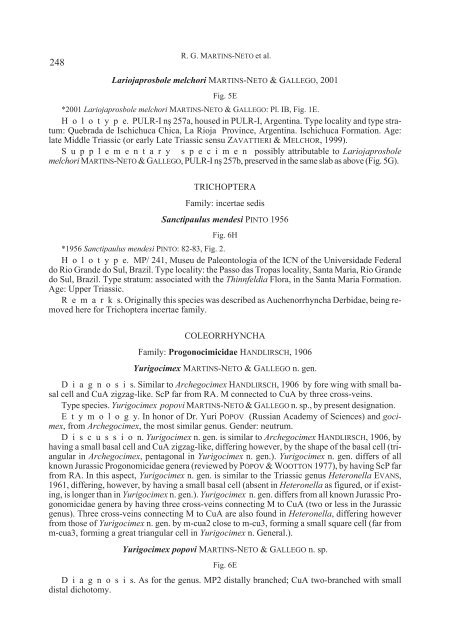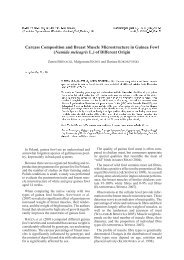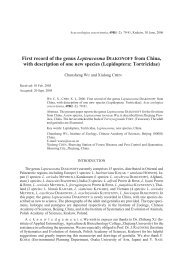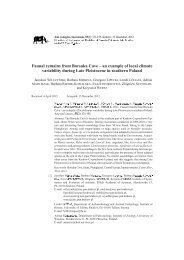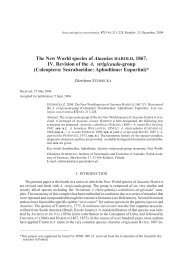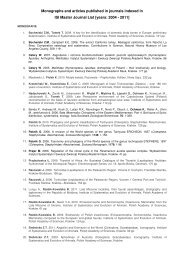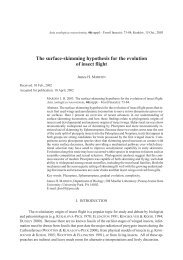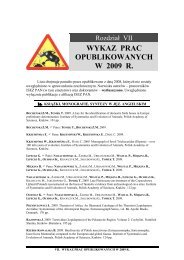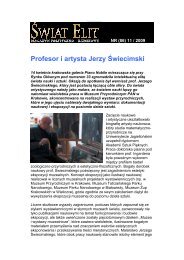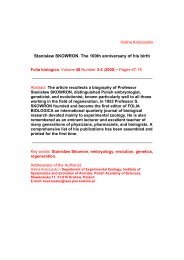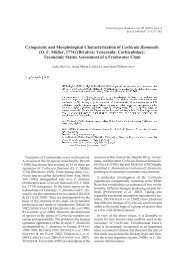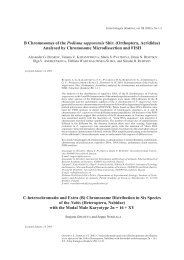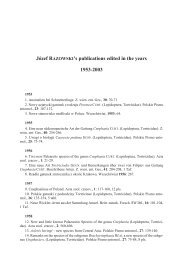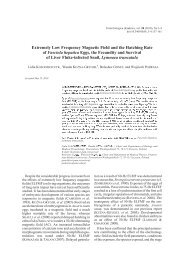Rafael Gioia MARTINS-NETO, Oscar Florencio GALLEGO
Rafael Gioia MARTINS-NETO, Oscar Florencio GALLEGO
Rafael Gioia MARTINS-NETO, Oscar Florencio GALLEGO
You also want an ePaper? Increase the reach of your titles
YUMPU automatically turns print PDFs into web optimized ePapers that Google loves.
248<br />
R. G. <strong>MARTINS</strong>-<strong>NETO</strong> et al.<br />
Lariojaprosbole melchori <strong>MARTINS</strong>-<strong>NETO</strong> &<strong>GALLEGO</strong>, 2001<br />
Fig. 5E<br />
*2001 Lariojaprosbole melchori <strong>MARTINS</strong>-<strong>NETO</strong> &<strong>GALLEGO</strong>: Pl. IB, Fig. 1E.<br />
Holotype.PULR-I nº 257a, housed in PULR-I, Argentina. Type locality and type stratum:<br />
Quebrada de Ischichuca Chica, La Rioja Province, Argentina. Ischichuca Formation. Age:<br />
late Middle Triassic (or early Late Triassic sensu ZAVATTIERI &MELCHOR, 1999).<br />
Supplementary specimen possibly attributable to Lariojaprosbole<br />
melchori <strong>MARTINS</strong>-<strong>NETO</strong> &<strong>GALLEGO</strong>, PULR-I nº 257b, preserved in the same slab as above (Fig. 5G).<br />
TRICHOPTERA<br />
Family: incertae sedis<br />
Sanctipaulus mendesi PINTO 1956<br />
Fig. 6H<br />
*1956 Sanctipaulus mendesi PINTO: 82-83, Fig. 2.<br />
Holotype.MP/241, Museu de Paleontologia of the ICN of the Universidade Federal<br />
do Rio Grande do Sul, Brazil. Type locality: the Passo das Tropas locality, Santa Maria, Rio Grande<br />
do Sul, Brazil. Type stratum: associated with the Thinnfeldia Flora, in the Santa Maria Formation.<br />
Age: Upper Triassic.<br />
Remarks.Originally this species was described as Auchenorrhyncha Derbidae, being removed<br />
here for Trichoptera incertae family.<br />
COLEORRHYNCHA<br />
Family: Progonocimicidae HANDLIRSCH, 1906<br />
Yurigocimex <strong>MARTINS</strong>-<strong>NETO</strong> &<strong>GALLEGO</strong> n. gen.<br />
Diagnosis.Similar to Archegocimex HANDLIRSCH, 1906 by fore wing with small basal<br />
cell and CuA zigzag-like. ScP far from RA. M connected to CuA by three cross-veins.<br />
Type species. Yurigocimex popovi <strong>MARTINS</strong>-<strong>NETO</strong> &<strong>GALLEGO</strong> n. sp., by present designation.<br />
Etymology.Inhonor of Dr. Yuri POPOV (Russian Academy of Sciences) and gocimex,<br />
from Archegocimex, the most similar genus. Gender: neutrum.<br />
Discussion.Yurigocimex n. gen. is similar to Archegocimex HANDLIRSCH, 1906, by<br />
having a small basal cell and CuA zigzag-like, differing however, by the shape of the basal cell (triangular<br />
in Archegocimex, pentagonal in Yurigocimex n. gen.). Yurigocimex n. gen. differs of all<br />
known Jurassic Progonomicidae genera (reviewed by POPOV &WOOTTON 1977), by having ScP far<br />
from RA. In this aspect, Yurigocimex n. gen. is similar to the Triassic genus Heteronella EVANS,<br />
1961, differing, however, by having a small basal cell (absent in Heteronella as figured, or if existing,<br />
is longer than in Yurigocimex n. gen.). Yurigocimex n. gen. differs from all known Jurassic Progonomicidae<br />
genera by having three cross-veins connecting M to CuA (two or less in the Jurassic<br />
genus). Three cross-veins connecting M to CuA are also found in Heteronella, differing however<br />
from those of Yurigocimex n. gen. by m-cua2 close to m-cu3, forming a small square cell (far from<br />
m-cua3, forming a great triangular cell in Yurigocimex n. General.).<br />
Yurigocimex popovi <strong>MARTINS</strong>-<strong>NETO</strong> &<strong>GALLEGO</strong> n. sp.<br />
Fig. 6E<br />
Diagnosis.Asforthegenus. MP2 distally branched; CuA two-branched with small<br />
distal dichotomy.


